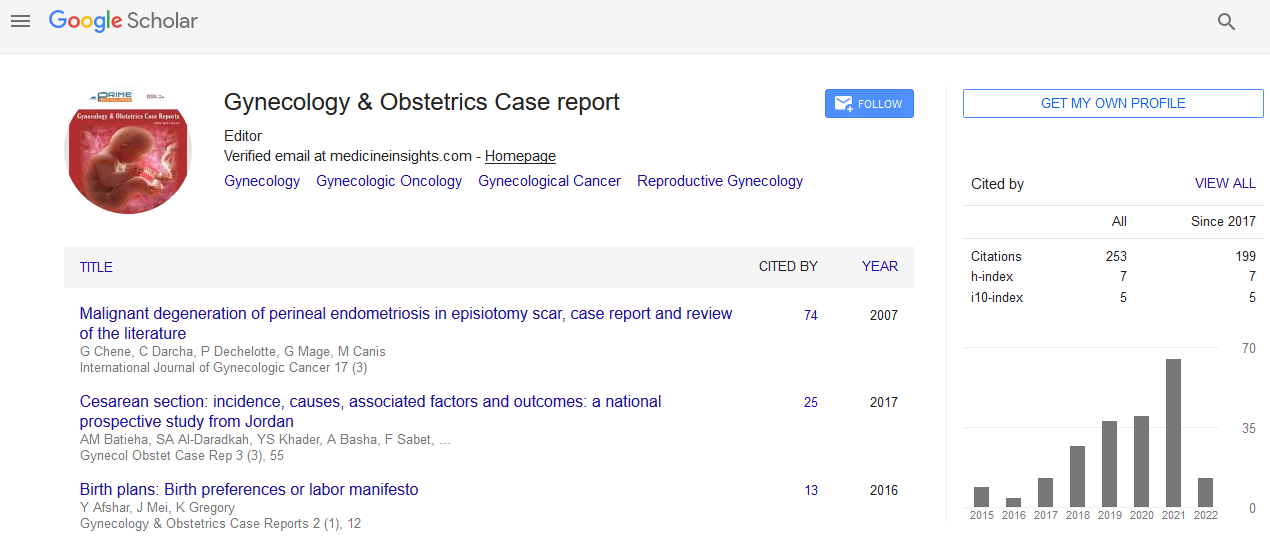Sheng Sun Mei1, Jewan Pariyar1*, Zhao Yan Yan1, Kalu Singh Khatri2, Palikhe Bishnu1 and He Jian1
1Department of Obstetrics and Gynaecology, Jiamusi University, Jiamusi, Heilongjiang, China
2Department of Oral and Maxillofacial Surgery, National Academy of Medical Sciences, Nepal
*Corresponding Author:
Jewan Pariyar
Department of Obstetrics and Gynaecology Jiamusi University, Jiamusi, Heilongjiang, China
Tel: +86-454-879-6220
E-mail: jewan_061@hotmail.com
Received date: 18 October, 2016; Accepted date: 21 November, 2016; Published date: 23 November, 2016
Citation: Sun Mei S, Pariyar J, Yan ZY, et al. A case report of pregnancy in rudimentary horn. Gynecol Obstet Case Rep. 2016, 2:3.
Keywords
Pregnancy; Rudimentary horn; Unicornuate uterus
Introduction
Initially, rudimentary horn was described by Latto et al. [1]. Incidence of pregnancy in rudimentary horn is as low as 1 in 150,000 [2]. Due to rarity of such cases very few literatures are found to be reported. Here, we report a case of right unicornuate uterus with non-communicating pregnant rudimentary horn diagnosed intra-operatively.
Case Report
A 29 years primi-gravida lady at 7+4 weeks of gestation reported to department of gynaecology and obstetrics at first affiliated hospital of Jiamusi University as a referral case from a local rural health care center. She was presented for antenatal visit at local rural health center where on ultrasound scan left adnexal mass was revealed and serum β-hcG was 399 mIU/L. She was referred as a case of suspicious ectopic pregnancy.
In our hospital, on general examination her vital signs were stable, with no any complain of lower abdominal pain, pervaginal bleeding. On physical and per abdominal examination we could not elicit any signs of ectopic pregnancy. Bimanual examination revealed bulky uterus with mass in left adnexa. Ultrasound showed empty uterus with thick endometrial layer with a mass in left adnexa of size (54 × 43 mm) with viable gestational sac (16 × 11 mm). Bilateral ovary was normal. Her serum β-hcG was 105, 314 mIU/L.
She was diagnosed with preoperative diagnosis of left sided ectopic pregnancy and planned for laparoscopy. Intraoperatively a right unicornuate uterus of size (6.5 × 5.5 × 4.5 cm) with normal ovary and fallopian tube was found. To the left there was a rudimentary horn of uterus (5 × 4.5 × 4.5 cm) with normal fallopian tube, ovary, and round ligament. There was a single cervix and single vagina. The probe was not able to enter though the rudimentary horn of uterus. So, the diagnosis of right uncorniate uterus with non-communicating pregnant rudimentary horn was confirmed. Resection of rudimentary horn with repair of damaged uterine wall and fallopian tube was done. Post-operatively patient was discharged on 5th day uneventfully.
Discussion
Unicornuate uterus anomaly occurs when one müllerian duct fails to develop or incompletely develops [3]. According to classification of müllerian anomalies by American society of reproductive medicine, unicornuate non-communicating rudimentary horn is classified as class IIb [4]. Trans-peritoneal migration of sperm or fertilized ovum leads to pregnancy in rudimentary horn [5].
Although majority of rudimentary horn pregnancy present following uterine rupture but in current case there was no typical sign and symptoms except for skipped cycles. Most of literature emphasized that patient with pregnant rudimentary horns are complicated with pain abdomen, first and second trimester abortion, ectopic pregnancy, preterm delivery, premature rupture of membrane, fetal death and intrauterine growth retardation [6]. Although, 40% women with this anomaly have renal anomalies but with this case the renal scan was normal [7].
Most of the literatures report ultrasound as choice of preoperative investigation but in this case ultrasound was inconclusive with diagnosis of left adnexal mass with possible ectopic pregnancy. Many literatures focused on pre-operative diagnosis by ultrasound and reconfirmation by magnetic imaging which is regarded as best diagnostic tool till date [4,8].
Most of the clinicians agree that pregnancy in rudimentary horn must be terminated as soon as diagnosed. But in current case instead of rudimentary horn initial provisional diagnosis was ectopic pregnancy and as per the standard protocol for ectopic is managed by laparoscopy and intra-operatively the diagnosis of pregnant rudimentary horn was confirmed. This changed diagnosis did not impact management protocol [9].
Postoperatively histopathological examination of surgical specimen reaffirmed the intra-operative diagnosis of rudimentary horn pregnancy.
Consent
An informed written consent was obtained from the patient for the publication of paper and required images.
Conclusion
Pregnancy in rudimentary horn is very rare which limits the overall knowledge and understanding of disease. Though most of the clinicians accept that pregnant rudimentary horn present with some clinical features but sometime they can present very silently without any signs.
References
- Latto D, Norman R (1950) Pregnancy in a rudimentary horn of a bicornuate uterus. Br Med J 2: 926-927.
- Moawad GN, Abi Khalil ED (2016) A Case of recurrent rudimentary horn ectopic pregnancies managed by methotrexate therapy and laparoscopic excision of the rudimentary horn. Case Rep Obstet Gynecol 5747524.
- Heinonen PK (1997) Unicornuate uterus and rudimentary horn. Fertil Steril 68: 224-230.
- Khati NJ, Frazier AA, Brindle KA (2012) The unicornuate uterus and its variants: Clinical presentation, imaging findings, and associated complications. J Ultrasound Med 31: 319-331.
- Nahum GG, Stanislaw H, McMahon C (2004) Preventing ectopic pregnancies: How often does transperitoneal transmigration of sperm occur in effecting human pregnancy? Bjog 111: 706-14.
- Reichman D, Laufer MR, Robinson BK (2009) Pregnancy outcomes in unicornuate uteri: A review. Fertil Steril 91: 1886-1894.
- Fedele L, Bianchi S, Agnoli B, Tozzi L, Vignali M (1996) Urinary tract anomalies associated with unicornuate uterus. J Urol 155(3): 847-248.
- Scarsbrook AF, Moore NR (2003) MRI appearances of mullerian duct abnormalities. Clin Radiol 58: 747-754.
- Jayasinghe Y, Rane A, Stalewski H, Grover S (2005) The presentation and early diagnosis of the rudimentary uterine horn. Obstet Gynecol 105: 1456-67.

